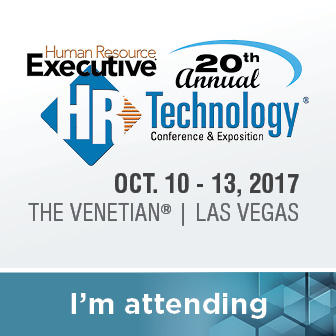HRE Column: HR Tech Conference Preview #1
Once again, I offer my semi-frequent reminder and pointer for blog readers that I also write a monthly column at Human Resource Executive Online called Inside HR Tech that can be found here.
This month, as I have been wrapping up the program development for the upcoming HR Technology Conference that will be held at in October, I take a look at some of the more interesting trends and themes in HR tech that have emerged from reviewing about 450 proposals and talking with dozens of HR leaders and technology service providers. These issues demand continuing focus for HR leaders and the spotlight will be placed on them at the Conference this fall.
So in this month's HR Executive column I examine a a few of these technologies and trends that are continuing to be top of mind for HR leaders and HRIT leaders and that will be on display at the Conference in October. There are of course a few other themes and trends that are important, but I could not fit them all into the HRE piece. I will probably touch upon some of them in next month's column.
I am super excited of what is in store at the event and plan to share as many of the big ideas that will be showcased there in the next few months both at HRE and here on the blog as well as the HR Happy Hour Show.
Here's a taste of the HRE piece:
As I write this, we are about two and half weeks from the official launch of the program for the 20th Annual HR Technology® Conference and Exposition, which will be held at the Venetian Resort in Las Vegas from Oct. 10-13. Developing the program for the event consists of a combination of reviewing approximately 450 "official" speaking proposals, having dozens of discussions with potential speakers, attending numerous industry events to see speakers in person as well as connect with HR technology providers, and finally, attempting to read and review as many sources of HR tech industry news and information as time allows.
From all of these activities, I come up with a conference program that accurately reflects the current state of HR technology in organizations, showcases innovative and forward-looking HR and HR tech thinking, and presents an event where HR and HRIT leaders can learn, see and experience all the best of HR tech in one place.
And each year, as I close up the process of program development, I like to take a step back to examine the overall themes and concepts that have coalesced from the process in order to draw some observations and conclusions about the current (and future) state of HR technology. From that perspective, here are some key observations and themes that I have seen from this process that reveal insights into HR tech, and that act as a bit of a preview of what you can expect at the conference.
Recruiting remains critical and competitive
One consistent finding in my five years of conference programming has been that most new technologies that come across my desk are centered on recruiting. When companies are expanding and opportunities for growth often hinge on finding new talent, the need for new tools, approaches and processes to power more effective recruiting becomes essential. We will continue to explore the evolution of recruiting technology and processes at HR Tech this year, with a focus on how modern technologies are enabling organizations to succeed in meeting their recruiting objectives. One specific area we will focus on is how organizations of all sizes are approaching the design, build and integration of the assortment of recruiting technologies that are available. Additionally, expect to see an incredible array of new and innovative recruiting technologies in our Startup Pavilion as well as being featured in our "Discovering the Next Great HR Technology Company" session.
Technology powers engagement
Employee engagement remains an important subject for organizations and HR leaders, as engagement levels have remained fairly constant -- and not very high -- for many years. But this challenge also represents an opportunity and many HR technology providers have developed solutions to address these challenges.
Read the rest at HR Executive Online...
If you liked the piece you can sign up over at HRE to get the Inside HR Tech Column emailed to you each month. There is no cost to subscribe, in fact, I may even come over and re-surface your driveway, take your dog for a walk, or help you weed the garden.
Have a great day and Happy Mother's Day to all the Moms out there!

 Steve
Steve



